

Vortex ring state. Vortex ring state, in which airflow is upward on the inner blade section, producing a secondary vortex in addition to the normal wingtip vortices.

Turbulent airflow results and loss of rotor efficiency. If allowed to continue, uncommanded pitch and roll oscillations may occur, with a large descent rate.[1] This condition also occurs with tiltrotors, and was responsible for an accident involving a V-22 Osprey. Vortex ring state caused the loss of a heavily modified MH-60 helicopter during Operation Neptune Spear, the 2011 raid in which Osama bin Laden was killed.[3] Description[edit] The curved arrows indicate airflow circulation about the rotor disc. List of online databases. List of academic databases and search engines. Wikipedia list article This page contains a representative list of notable databases and search engines useful in an academic setting for finding and accessing articles in academic journals, institutional repositories, archives, or other collections of scientific and other articles.
Ontology (information science) While the etymology is Greek, the oldest extant record of the word itself, the New Latin form ontologia, appeared in 1606 in the work Ogdoas Scholastica by Jacob Lorhard (Lorhardus) and in 1613 in the Lexicon philosophicum by Rudolf Göckel (Goclenius).
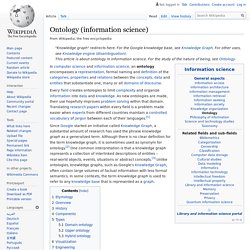
The first occurrence in English of ontology as recorded by the OED (Oxford English Dictionary, online edition, 2008) came in Archeologia Philosophica Nova or New Principles of Philosophy by Gideon Harvey. Contemporary ontologies share many structural similarities, regardless of the language in which they are expressed. Database journalism. Database journalism or structured journalism is a principle in information management whereby news content is organized around structured pieces of data, as opposed to news stories.
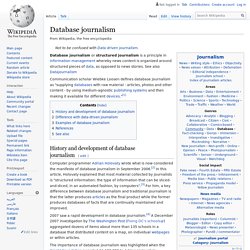
See also Datajournalism Communication scholar Wiebke Loosen defines database journalism as "supplying databases with raw material - articles, photos and other content - by using medium-agnostic publishing systems and then making it available for different devices. "[1] Zooming user interface. Example of a ZUI When the level of detail present in the resized object is changed to fit the relevant information into the current size, instead of being a proportional view of the whole object, it's called semantic zooming.[1] Some experts consider the ZUI paradigm as a flexible and realistic successor to the traditional windowing GUI, being a Post-WIMP interface.
But little effort is currently spent developing ZUIs, while there are ongoing efforts for developing other types of GUIs. Xaitment. Products[edit] xaitment currently sells two AI software modules: xaitMap and xaitControl. xaitMap provides runtime libraries and graphical tools for navigation mesh generation (also called NavMesh generation), pathfinding, dynamic collision avoidance, and individual and crowd movement. xaitControl is a finite-state machine for game logic and character behavior modeling that also includes a real-time debugger.
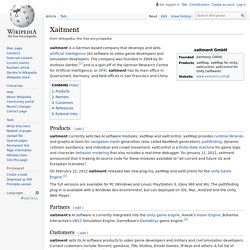
On January 11, 2012, xaitment announced that it making its source code for these modules available to "all current and future US and European licensees". The full versions are available for PC (Windows and Linux), PlayStation 3, Xbox 360 and Wii. The pathfinding plug-in is available with a Windows dev environment, but can deployed on iOS, Mac, Android and the Unity Web Player. XSLT. XSLT (eXtensible Stylesheet Language Transformations) is a language for transforming XML documents into other XML documents,[1] or other formats such as HTML for web pages, plain text or XSL Formatting Objects, which may subsequently be converted to other formats, such as PDF, PostScript and PNG.[2] XSLT 1.0 is widely supported in modern web browsers.[3] The original document is not changed; rather, a new document is created based on the content of an existing one.[4] Typically, input documents are XML files, but anything from which the processor can build an XQuery and XPath Data Model can be used, such as relational database tables or geographical information systems.[1]

XQuery. Functional programming and query language for XML XQuery (XML Query) is a query and functional programming language that queries and transforms collections of structured and unstructured data, usually in the form of XML, text and with vendor-specific extensions for other data formats (JSON, binary, etc.).
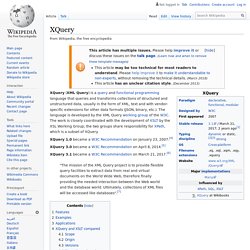
The language is developed by the XML Query working group of the W3C. The work is closely coordinated with the development of XSLT by the XSL Working Group; the two groups share responsibility for XPath, which is a subset of XQuery. XQuery 1.0 became a W3C Recommendation on January 23, 2007.[4] XQuery 3.0 became a W3C Recommendation on April 8, 2014.[5] XLink. XML Linking Language, or XLink, is an XML markup language and W3C specification that provides methods for creating internal and external links within XML documents, and associating metadata with those links.[1] The XLink specification[edit] XLink 1.1 is a W3C recommendation[2] and the successor of XLink 1.0, which was also a W3C recommendation.[3][4] Linking with XLink[edit] Simple links[edit] A simple link creates a unidirectional hyperlink from one element to another via a URI.

XInclude. XInclude is a generic mechanism for merging XML documents, by writing inclusion tags in the "main" document to automatically include other documents or parts thereof.[1] The resulting document becomes a single composite XML Information Set.
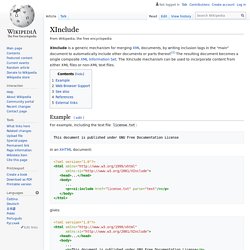
The XInclude mechanism can be used to incorporate content from either XML files or non-XML text files. Example[edit] For example, including the text file license.txt: Writers Guild of America Awards 2018. The 71st Writers Guild of America Awards honored the best in film, television, radio and video-game writing of 2018.
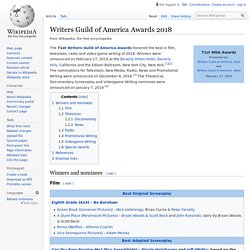
Winners were announced on February 17, 2019 at the Beverly Hilton Hotel, Beverly Hills, California and the Edison Ballroom, New York City, New York.[1][2] The nominations for Television, New Media, Radio, News and Promotional Writing were announced on December 6, 2018.[3] The Theatrical, Documentary Screenplay and Videogame Writing nominees were announced on January 7, 2019.[4] Winners and nominees[edit] Film[edit] Wrapper function. Purpose[edit] Programming convenience[edit] Wrapper functions can be used to make writing computer programs easier.
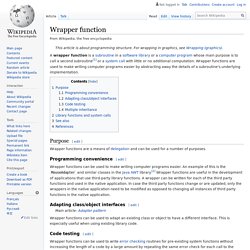
An example of this is the MouseAdapter and similar classes in the Java AWT library.[2] Wrapper functions are useful in the development of applications that use third-party library functions. A wrapper can be written for each of the third party functions and used in the native application. Workflow. An IMRAD model for developing research articles. Windows Script Host. It is language-independent in that it can make use of different Active Scripting language engines. By default, it interprets and runs plain-text JScript (.JS and .JSE files) and VBScript (.VBS and .VBE files). Users can install different scripting engines to enable them to script in other languages, for instance PerlScript. The language independent filename extension WSF can also be used. The advantage of the Windows Script File (.WSF) is that it allows multiple scripts ("jobs") as well as a combination of scripting languages within a single file.
Windows Management Instrumentation. Microsoft also provides a command-line interface to WMI called Windows Management Instrumentation Command-line (WMIC).[3] Purpose of WMI[edit] The purpose of WMI is to define a proprietary set of environment-independent specifications which allow management information to be shared between management applications. WMI prescribes enterprise management standards and related technologies for Windows that work with existing management standards, such as Desktop Management Interface (DMI) and SNMP.
WMI complements these other standards by providing a uniform model. This model represents the managed environment through which management data from any source can be accessed in a common way. Whiteboard animation. Whiteboard animation video example. White-label product. Web service. Web search engine. Software system that is designed to search for information on the World Wide Web. Web scraping. Web science. Human behavior co-constituting the web. Web science is an emerging interdisciplinary field concerned with the study of large-scale socio-technical systems, particularly the World Wide Web.[1][2] It considers the relationship between people and technology, the ways that society and technology co-constitute one another and the impact of this co-constitution on broader society.
Web literacy. Web intelligence. Web 2.0 for development. WebVR. WebVR is an experimental JavaScript application programming interface (API) that provides support for virtual reality devices, such as the HTC Vive, Oculus Rift, Google Cardboard or OSVR in a web browser.[1] This API is designed with the following goals in mind:[2] Detect available Virtual Reality devices.Query the devices capabilities.Poll the device’s position and orientation.Display imagery on the device at the appropriate frame rate. Volume serial number. Video game music. Video game design. Video design. Value chain. User agent. Unified Modeling Language. Typosquatting. Treebank. Topic map. Time series. Think tank. The Wachowskis. Terminology extraction. Terminal emulator.
Template processor. Telnet. Taxonomy. Tastebuds.fm. Supply-chain management. Style guide. Structural equation modeling. Strategy guide. Standard Generalized Markup Language. Stagecraft. Speech Synthesis Markup Language. Sound design. Software agent. Social sequence analysis. Social networking service. Snippet (programming) Slidecasting. Shodan (website) Service design. Semantic search. Semantic network.
Semantic Web. Semantic Geospatial Web. Security Assertion Markup Language. Secure Shell. Search/Retrieve via URL. Scrum (software development) Scripting language. SPARQL. Regular expression. Recommender system. Query language. Programming domain. Product design. Process modeling. Process control. Pipeline (computing) Pastebin. Paging. Packet analyzer. PQL. Overview of RESTful API Description Languages. Outline of thought. Outline of artificial intelligence. Open Semantic Framework. OpenSearch. OpenLayers. OpenAPI Specification. Online analytical processing. OASIS (organization) Newsgame. Monte Carlo method. Mixin. Metabrowsing. Mensa International. Matte painting. Matte painting. Mashup (web application hybrid) Loot box.